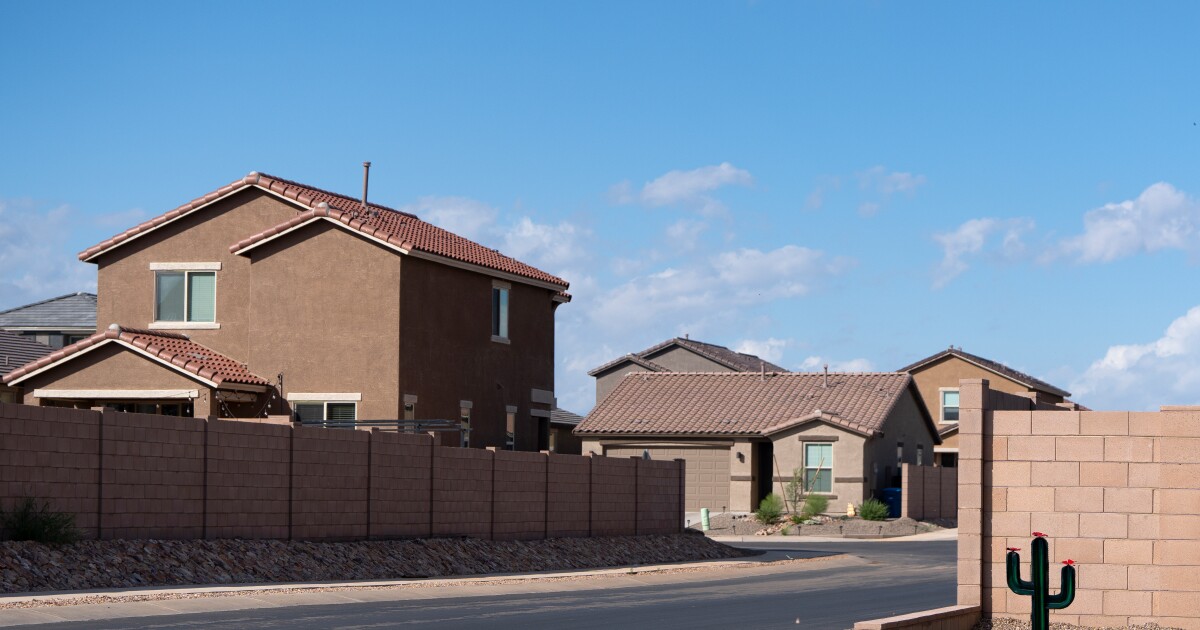
A severe shortage of new homes hasn't stopped builders from dropping their prices.
El Paso, Texas-based Tropicana Homes hasn't seen any hesitancy from consumers interested in their new construction, which carries price tags above the local median price between $220,000 to $250,000 according to brokerages. The builder's buydowns and price cuts are drawing business as the existing home market is plagued by the
"We match the rate of the bank they would've gone with, and they get all their closing costs paid for, including the credit report and the appraisal," said Sylvia Sandoval, a longtime salesperson with the company. "Nobody walks away from a $10,000 contribution."
The nation's housing market needs
That median price however was unchanged from a year ago, federal data said. The NAHB reports about a third of builders cutting prices in October, with an average price reduction of 6%. About 62% of builders used sales incentives in October, a similar pace to when rates were
"I haven't had any pushback waiting for rates to drop more, because when I'm offering them 5% or 5.25%, or right under 5%, they're comfortable," said Sandoval. "It's not a horrible rate, but they're not going to get a 3% interest rate."
Mortgage rates are showing no signs of fading toward the ultra-low ranges of yesteryear. On Election Day, the 30-year fixed-rate mortgage was above 7%,
Nearly two-thirds of Texas builder D.R. Horton's clients used the company's financing arm, and over 80% of them had some form of a rate buydown in the fiscal 2024 fourth quarter, the company said in a recent earnings report. Its average rate promotion in the period was between 4.5% to 5.5%, remaining in the 1% to 1.5% range below market rates over the past few quarters.
Builder headwinds
The factors that drove a lack of home building in the last decade are making it more expensive to construct today. NAHB senior vice president and chief economist Rob Dietz described the industry as facing difficulties in the 5 "L's": labor, lots, lending, lumber, and legal issues.
Construction loans carry rates between 12% to 14%, and those funds are responsible for about 60% of a builder's construction activity, said Dietz. Zoning rules, along with more building, design and setback requirements have all strained supply.
The trade group in its most recent version of a five-year survey found "about a quarter of the final sales prices of typical newly built single family homes is due not to materials or labor, but rather to various regulatory costs, fees and taxes," said Dietz.
In March, the NAHB reported 76.9% of all U.S. households
Federal data showed new home prices are more palatable. In another positive sign, U.S. Census data for September showed new home sales priced below $300,000 made up 17% of new home transactions, compared to 14% a year ago.
New homes could be the more affordable option in the long run, compared to an existing property, experts said. Maintenance may be covered more often by a builder's warranty, and homes are likely to be more energy-efficient and resilient to natural disasters.
Buyers often aren't aware that those factors will usually allow for cheaper
"If it's a brand new home under the builder's warranty, then what's likely going to be a claim?" he said. "The chances that the homeowner is going to be putting in a claim is probably pretty low."
No pain, no gain
Publicly traded builders told investor analysts in earnings calls in the past few weeks that their sales incentives have made a dent in their profit margins.
Atlanta-based Pulte Group acknowledged as much, stating its incentives were up 70 basis points in the third quarter from the second quarter. Texas-based D.R. Horton said its gross profit margin on home sales revenue was down 40 basis points in its fiscal year fourth quarter, from the prior period, due to higher incentive costs.
"Our margin in the month of September was lower than it was in July and August, and we expect that trend to continue into Q1," said Bill Wheat, the firm's executive vice president and chief financial officer. "Where rates have recently gone, the cost of our interest rate buydowns are increasing, so that's why we expect our incentive levels to increase further."
Dietz said he's unsure of a "magic number" where builders would rescind buydowns, but anticipates a reduction as rates trend closer to 6%. Consumers can still turn to independent mortgage banks, like Crescenzo's Nation One team, to work on financing.
"Not often enough is our second opinion sought after," he said. "We see tremendous success in sometimes minor things, minor adjustments."
Publicly traded home builders in earnings conference calls said they're looking to the spring season to dictate future home building plans. The most recent data from the NAHB meantime showed new home sales in September up on both a monthly and annual basis.
A third of the current housing market is new construction, including homes that builders haven't begun construction on, said Dietz.
"But historically, new construction was only 12% of inventory," he said. "So high home prices on the resale side and the lock-in effect has led new construction to expand its footprint."



